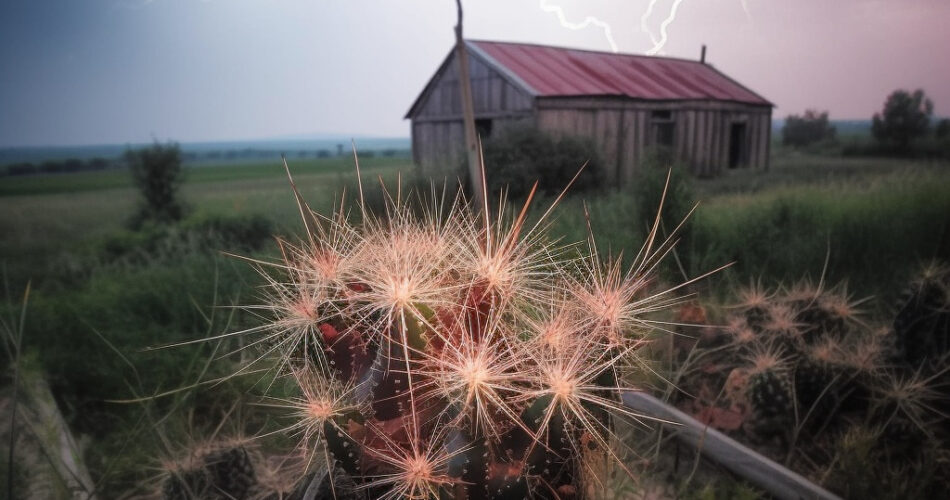Key Takeaways:
- Corynopuntia has distinctive features, including segmented stems and vibrant flowers.
- It has impressive adaptations such as water storage and heat protection through spines.
- Corynopuntia species exhibit a wide range of fruit colors and shapes, diverse spines, and varying sizes.
- Indigenous cultures have historically used this cactus for food, medicine, and construction.
- The discovery, naming, and migration of it reflect its intriguing botanical history.
- Care tips for cultivating this cacti include replicating optimal growing conditions, propagation techniques, and pest and disease prevention.
1. Unveiling the Intriguing Features of Corynopuntia
When it comes to the fascinating world of cacti, Corynopuntia stands out as a truly unique genus that captures the attention of plant enthusiasts across the globe. What makes Corynopuntia so intriguing are its distinctive features, from its morphology to its impressive adaptations to harsh environments.
Delving Into the Unique Morphology
This cactus showcases a range of morphological features that set it apart from other cacti. One of the most striking characteristics is its segmented stem, which consists of cylindrical or flattened joints known as cladodes. These cladodes perform photosynthesis, allowing the plant to thrive in arid conditions where water is scarce. The texture and color of the cladodes can vary among species, providing a visually appealing aspect to any garden or landscape.
Additionally, It produces vibrant flowers that add a splash of color to the desert. These flowers come in various hues such as yellow, orange, pink, and red, attracting pollinators like bees and hummingbirds. The beauty of these blossoms not only enhances the aesthetic appeal of the plants but also contributes to the overall ecological balance.
The Impressive Adaptations to Harsh Environments
It has evolved remarkable adaptations that enable it to survive in incredibly harsh environments. One prominent adaptation is its ability to store water in its stems, roots, and cladodes. This allows the plant to endure long periods of drought and thrive in arid regions where water is scarce. The capacity to store water also aids in minimizing the plant’s water loss through transpiration.
Furthermore, the spines found on Corynopuntia serve multiple purposes. Aside from providing defense against herbivores, the spines protect the plant from excessive heat by casting a shadow over the surface, reducing the impact of direct sunlight. This adaptation helps prevent the plant from drying out and maintains a moderate temperature within the cactus.
2. Exploring the Extraordinary Diversity of Corynopuntia Species
The genus Corynopuntia boasts an extraordinary diversity of species, each with its own distinct characteristics and visual appeal. Let’s delve into the mesmerizing colors and shapes of Corynopuntia fruits, unravel the secrets of its spines, and understand the size range exhibited by different Corynopuntia species.
The Mesmerizing Colors and Shapes of Corynopuntia Fruits
This cacti produces an array of fruits that are not only visually captivating but also play a vital role in seed dispersal. These fruits come in various shapes, including round, elongated, and tuberculate forms. What truly captivates observers, though, is the mesmerizing range of colors exhibited by these fruits. From vibrant oranges and reds to subtle greens and yellows, each fruit displays its own unique palette. These colorful fruits attract animals, such as birds and mammals, which consume them and later disperse the seeds as they move through the environment.
Unraveling the Secrets of Corynopuntia Spines: Defense Mechanisms and Beyond
The spines of Corynopuntia serve several crucial purposes beyond their defensive role. These structures are modified leaves that have evolved to protect the plant from herbivores and provide shade to prevent excessive water loss. Besides these practical functions, the spines also contribute to the cactus’s unique appearance. They can range in color from yellow and brown to black, and their lengths can vary between species. Some spines are long and thin, while others are shorter and stouter, adding diversity to the overall aesthetic of the plants.
From Tiny Miniatures to Towering Giants: Understanding the Size Range of Corynopuntia
Corynopuntia exhibits a remarkable size range, with some species growing as tiny miniatures, while others reach towering heights. The diminutive species, such as Corynopuntia minima, often have a creeping or compact growth habit, making them ideal choices for rock gardens or container cultivation. On the other end of the spectrum, the giant species, like Corynopuntia gigantea, can grow up to several meters in height, creating impressive focal points in gardens and landscapes. This vast size range allows enthusiasts to select the ideal Corynopuntia species based on the available space and desired landscape design.

3. Traveling Through the History and Origins of Corynopuntia
The story of this cactus extends beyond its fascinating biology. Exploring the history and origins of this unique genus takes us on a journey through ancient cultures, botanical discoveries, and the migration and distribution of these remarkable cacti.
Unearthing the Ancient Uses of It by Indigenous Cultures
It has a rich history of use by indigenous cultures in the regions where it naturally occurs. People have utilized various parts of the cactus for food, medicine, and even construction materials. The edible fruits and young cladodes provided a valuable source of nutrition, while the plant’s mucilaginous sap was employed in traditional medicine to treat ailments such as burns and irritated skin. Additionally, the strong and resilient spines were sometimes used as needles or awls for crafting tools or as components in construction materials.
The Discovery and Naming of Corynopuntia: A Botanical Adventure
The discovery and naming of this cactus reflect a fascinating chapter in botanical history. Early explorers and naturalists encountered these cacti during their expeditions and made significant efforts to document and classify the new genus. The process involved meticulous observations, careful preservation of specimens, and the collaboration of experts in the field. Ultimately, through their passion and dedication, the genus Corynopuntia was officially recognized and named, solidifying its place in the botanical world.
Tracking This Cactus Across Continents: Its Migration and Distribution
Corynopuntia species have expanded their distribution beyond their original habitats. This migration can be attributed to various factors, including human intervention and natural dispersal mechanisms. Over time, Corynopuntia species have been transported to different continents, adapting to new environments and establishing themselves in regions where they were previously absent. Understanding the migration patterns and distribution of Corynopuntia provides essential insights into the adaptability and resilience of these unique cacti.
4. Caring for Corynopuntia: Tips for Cultivating These Remarkable Cacti
Cultivating Corynopuntia in your own garden or indoor collection can be a rewarding experience. To ensure these remarkable cacti thrive and flourish, it is important to understand their optimal growing conditions, effective propagation techniques, and potential pests and diseases to be aware of.
Understanding the Optimal Growing Conditions
Corynopuntia thrives in arid and semiarid regions, so replicating these conditions is key to cultivating these cacti successfully. They require well-draining soil with a mix of sand and perlite, which mimics the natural desert habitat. Corynopuntia also requires ample sunlight to fuel its photosynthetic processes, so placing them in a location with direct sunlight for several hours per day is essential. Additionally, monitoring and adjusting watering practices to avoid overwatering is crucial for preventing root rot and maintaining the health of the plants.
Essential Steps in Propagating Corynopuntia: From Seeds to Cuttings
Propagating Corynopuntia can be achieved through various methods, including seeds and vegetative propagation. Growing these cacti from seeds requires patience and attention to detail, as specific conditions need to be met to encourage germination. Vegetative propagation, such as taking stem or pad cuttings, allows for a quicker and more reliable way to multiply Corynopuntia. This process involves carefully preparing and rooting the cuttings, ensuring they receive optimal growing conditions to establish healthy new plants.
Safeguarding Corynopuntia: Common Pests and Diseases to Watch Out For
While Corynopuntia is generally resilient, it is not immune to certain pests and diseases that can affect its health. Some common pests to watch out for include mealybugs, aphids, and scale insects. These can be controlled through various organic methods, such as using natural predators or employing targeted insecticidal treatments. Diseases like fungal infections or rot can occur if the plants are overwatered or exposed to prolonged high humidity. Regular monitoring and maintaining appropriate growing conditions will help prevent and manage these potential issues.
Corynopuntia is a captivating genus of cacti that offers an incredible blend of unique features, diverse species, and a rich history. Whether you are an avid cactus enthusiast or a curious beginner, delving into the world of Corynopuntia is a journey that will both educate and inspire. By understanding their fascinating morphology, exploring their extraordinary diversity, tracing their history and origins, and learning the art of their cultivation, one can truly appreciate the remarkable beauty and resilience of these exceptional cacti.
FAQ
Question: What makes Corynopuntia unique?
It stands out from other cacti with its distinctive features, including segmented stems and vibrant flowers.
Question: How does Corynopuntia adapt to harsh environments?
It has evolved water storage capabilities in its stems, roots, and cladodes, as well as heat protection through spines.
Question: What is the diversity of Corynopuntia species?
These cactuses exhibit a wide range of fruit colors and shapes, diverse spines, and varying sizes.
Question: What are the historical uses of Corynopuntia?
Indigenous cultures have historically used it for food, medicine, and construction.
Question: How was Corynopuntia discovered and named?
It was discovered and named through the efforts of early explorers and naturalists, who documented and classified the new genus.
Question: How did Corynopuntia migrate and distribute across continents?
These cacti have expanded their distribution through human intervention and natural dispersal mechanisms, adapting to new environments along the way.
Question: What are the care tips for cultivating Corynopuntia?
To cultivate it successfully, replicate optimal growing conditions, use effective propagation techniques, and be aware of common pests and diseases.
Question: How can Corynopuntia be propagated?
It can be propagated through seeds or vegetative methods such as stem or pad cuttings.




Comments